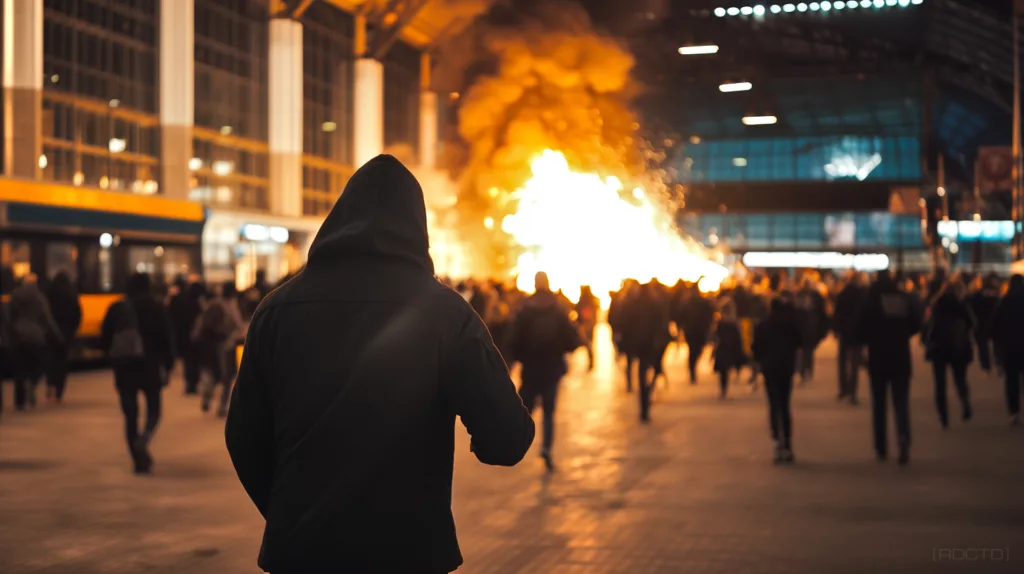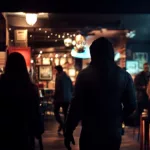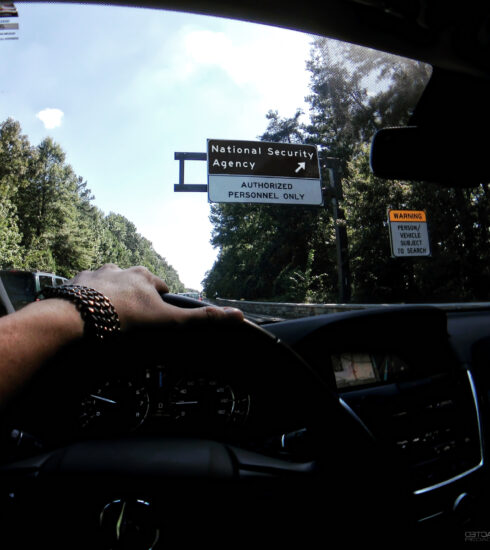Using Crowds as Early Warning Detection Systems
Crowds are more than just groups of people moving through public spaces – they’re living, breathing sensors.
Every crowd has a rhythm. When that rhythm breaks, an unseen force is at play.
When you know what to look for, crowds can serve as an early warning system for everything from impending threats to shifting social dynamics. Intelligence operatives, law enforcement, and security professionals use crowd behavior as a key indicator in threat detection.
Recognizing Anomalies in Crowds
A well-trained operative relies on tradecraft to spot deviations from the norm. Crowds have a natural flow, whether it’s in a busy marketplace, a transportation hub, or a protest. When something disrupts that rhythm – sudden dispersal, unnatural clustering, or erratic movements – it often signals trouble.
For example, in a dense urban environment, a sudden break in the crowd could indicate a concealed threat, like someone brandishing a weapon or an unexpected detonation. Similarly, a group of individuals moving with rigid coordination in an otherwise chaotic protest might be planning an escalation. Understanding these patterns is critical in preempting threats before they materialize.
Beyond major disruptions, micro-anomalies can also indicate trouble. Skilled operatives focus on subtle shifts that signal something is off. Unseasonable clothing, unnatural eye movements, or misplaced tension in a person’s posture can all be early indicators of an impending threat. The key is to develop a baseline understanding of normal behavior in a given environment so that deviations become immediately noticeable.
Example anomalies to watch for:
• Abrupt changes in crowd movement: Sudden stops, rapid dispersals, or unnatural clustering can indicate an emerging threat.
• Individuals scanning more than moving: A person who frequently scans their surroundings without a clear purpose may be conducting surveillance or preparing for an attack.
• Unusual clothing for the environment: Heavy coats in warm weather or bulky attire in controlled areas could suggest an attempt to conceal weapons or explosives.
• Tension in body language: A clenched jaw, stiff posture, or someone repeatedly adjusting their clothing might indicate nervousness before taking action.
• People avoiding eye contact or watching too intently: A lack of natural interaction with the environment can be a sign of someone attempting to remain unnoticed – or, conversely, someone locked onto a target.
• Objects left unattended: Bags, packages, or personal belongings abandoned in a crowded area should always be considered potential threats until confirmed otherwise.
Recognizing these indicators early allows for preemptive action. Whether that’s moving to a safer position, notifying security personnel, or initiating countermeasures. When it comes to crowds, the smallest details can mean the difference between prevention and reaction.
The Psychology of Collective Awareness
People in crowds pick up on subtle signals before they consciously recognize them. This “collective awareness” is an evolutionary survival instinct – when one person sees something off, their body language changes. Others around them pick up on that shift, creating a ripple effect. By monitoring those micro-reactions, an observant operative can detect potential danger before it becomes obvious.
This psychological phenomenon is often called the herd effect, where people unconsciously mimic the emotions and actions of those around them. It’s why a single person running in panic can trigger a stampede or why tension in a crowd can escalate rapidly. While most people follow the herd without question, a trained operative remains a step ahead, identifying what sparked the reaction rather than simply reacting to it. Recognizing when a crowd is on edge can mean the difference between controlling a situation and being caught in the chaos.
Example indicators of collective awareness shifts:
• Glance clustering: When multiple people suddenly look in the same direction, something noteworthy is happening.
• Unnatural silence: In normally loud environments, a sudden hush signals heightened attention or fear.
• Micro-exits: Individuals quietly slipping away from a gathering before an incident occurs often sense trouble before it erupts.
• Group tension: If people start standing rigidly, gripping belongings, or clenching fists, they may be preparing for an imminent threat.
• Directional shifts: Watch for waves of movement, if a crowd subtly reorients itself or begins shifting away from an unseen force, something is driving that motion.
By studying these signals, operatives and security professionals can predict crowd behavior before an incident fully unfolds.

Crowdsourcing Intelligence in Real Time
With the rise of social media, monitoring crowd reactions has gone digital. Posts, tweets, and live streams provide raw, real-time intelligence that can reveal an emerging crisis. In active operations, operatives and analysts alike can sift through this digital noise to identify early indicators – spikes in geotagged mentions of disturbances, eyewitness footage of anomalies, or patterns of misinformation spreading ahead of a coordinated attack.
Beyond digital monitoring, traditional HUMINT (human intelligence) collection still plays a major role. Taxi drivers, street vendors, and local shopkeepers are some of the best sources of real-time crowd intelligence. They notice changes before outsiders do, making them invaluable assets for early warning.
To maximize the effectiveness of crowdsourced intelligence, operatives and analysts should:
• Monitor sudden spikes in digital activity: A rapid increase in posts, videos, or messages from a specific area often signals a developing situation.
• Cross-reference multiple sources: A single post can be misleading; verifying information from different angles helps filter out noise and disinformation.
• Identify key influencers: Certain individuals, such as journalists, activists, or local figures, often provide the earliest and most reliable reports.
• Track movement patterns through geotagging: Mapping out where reports originate can reveal the direction of an emerging threat or highlight unexpected focal points.
• Look for coded language or indirect warnings: Criminal groups, terrorists, and insurgents often use slang, emojis, or seemingly unrelated phrases to communicate threats.
• Engage with trusted ground assets: Direct communication with people on-site, like local contacts or embedded sources, can confirm or deny digital intelligence.
By combining traditional tradecraft with modern data analysis, operatives can turn crowdsourced information into actionable intelligence, staying one step ahead of developing threats.
Training Yourself to Read a Crowd
Threat and danger detection with situational awareness is a skill that can be developed with practice. Next time you’re in a crowded setting, pay attention to:
Over time, you’ll start noticing patterns without consciously thinking about them, sharpening your instincts for detecting anomalies before they escalate into threats.
Real-World Examples of Crowd Warnings
Sudden Silence in a Marketplace: In a bustling street market, vendors and shoppers suddenly go quiet and start looking in the same direction. This could indicate an approaching threat, such as a fight, an armed individual, or even an undercover law enforcement presence.
Mass Exodus from a Public Event: At a concert or stadium, if groups of people begin rapidly leaving before the event is over, it could signal an emerging security threat – such as an active shooter, an unseen fire, or even rumors of danger spreading through the crowd.
Coordinated Phone Checking in a Public Space: If multiple people in a crowd check their phones simultaneously, especially in a setting where that’s unusual (like a security checkpoint or a political rally), it could indicate that they’re receiving coordinated instructions for an operation – whether that’s a protest maneuver or something more sinister.
Passengers Abandoning a Subway Platform: If a train platform is packed but people suddenly start backing away from the edge or shifting toward exits, they may have sensed a danger – an unstable individual, a potential pickpocket, or even an approaching threat on the tracks.
Tourists Following Local Behavior: In areas prone to natural disasters, locals are often the first to recognize early warning signs. If you’re traveling and notice shopkeepers boarding up windows or residents abruptly leaving, it might be time to follow their lead before an earthquake, storm, or other crisis unfolds.
Dispersal Near a High-Profile Target: In war zones or politically unstable regions, people living nearby often detect subtle precursors to attacks. If civilians near a government building or embassy start clearing out without explanation, they may have picked up on an imminent threat like an airstrike or planned assault.
Unnatural Clustering in a Protest: During a demonstration, most people move chaotically. However, if small groups suddenly form tight circles and communicate discreetly, it could be a sign of planned escalation, such as an attack on law enforcement or a coordinated disruption.
Street Performers Packing Up Abruptly: Buskers, street vendors, and taxi drivers often have an intuitive sense of their environment. If they start packing up and leaving without an obvious reason, it could mean they’ve sensed rising tension – anything from an impending police raid to an escalating confrontation nearby.
These examples highlight how a well-trained eye can detect warning signs just by observing crowd behavior. The key is recognizing the subtle shifts before they escalate into full-blown crises.
The flow of a crowd is like a river – when it changes course suddenly, there’s a reason.
Whether in the field or behind a screen, understanding the dynamics of human movement and reaction can provide an invaluable early warning system. It’s not just about watching the crowd – it’s about reading it.
[INTEL : Threat Recognition Instincts]
[OPTICS : Undisclosed, Germany]







